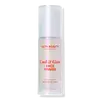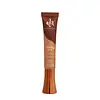What's inside
What's inside
 Key Ingredients
Key Ingredients

 Benefits
Benefits

 Concerns
Concerns

 Ingredients Side-by-side
Ingredients Side-by-side

Water
Skin ConditioningCaprylic/Capric Triglyceride
MaskingPropanediol
SolventOctyldodecanol
EmollientButylene Glycol
HumectantSodium Acrylates Copolymer
Menthyl Lactate
Masking1,2-Hexanediol
Skin ConditioningDiglycerin
HumectantMenthone Glycerin Acetal
RefreshingLecithin
EmollientHydroxyacetophenone
AntioxidantTin Oxide
AbrasiveVaccinium Myrtillus Seed Oil
Skin ConditioningMica
Cosmetic ColorantTitanium Dioxide
Cosmetic ColorantWater
Skin ConditioningGlycerin
HumectantPropylene Glycol
Humectant2,3-Butanediol
HumectantGlycereth-26
HumectantSqualane
EmollientNiacinamide
Smoothing1,2-Hexanediol
Skin ConditioningCetyl Ethylhexanoate
EmollientFicus Carica Fruit Extract
HumectantPunica Granatum Fruit Extract
AntioxidantHylocereus Undatus Fruit Extract
Skin ConditioningActinidia Chinensis Fruit Extract
EmollientFragaria Chiloensis Fruit Extract
Skin ConditioningZingiber Officinale Root Oil
MaskingCurcuma Longa Root Oil
PerfumingCurcumin
AntioxidantLinum Usitatissimum Seed Oil
PerfumingSimmondsia Chinensis Seed Oil
EmollientGlycyrrhiza Uralensis Root Extract
Skin ConditioningSodium Hyaluronate
Humectant3-O-Ethyl Ascorbic Acid
Skin ConditioningAmmonium Acryloyldimethyltaurate/Beheneth-25 Methacrylate Crosspolymer
Emulsion StabilisingButylene Glycol
HumectantEthylhexylglycerin
Skin ConditioningParfum
MaskingGlyceryl Stearate
EmollientGlyceryl Acrylate/Acrylic Acid Copolymer
HumectantHydroxyacetophenone
AntioxidantIsohexadecane
EmollientMica
Cosmetic ColorantPhenoxyethanol
PreservativePolysorbate 80
EmulsifyingPvm/Ma Copolymer
Emulsion StabilisingSodium Acrylate/Sodium Acryloyldimethyl Taurate Copolymer
Emulsion StabilisingSorbitan Oleate
EmulsifyingCI 77891
Cosmetic ColorantTocopheryl Acetate
AntioxidantXanthan Gum
EmulsifyingWater, Glycerin, Propylene Glycol, 2,3-Butanediol, Glycereth-26, Squalane, Niacinamide, 1,2-Hexanediol, Cetyl Ethylhexanoate, Ficus Carica Fruit Extract, Punica Granatum Fruit Extract, Hylocereus Undatus Fruit Extract, Actinidia Chinensis Fruit Extract, Fragaria Chiloensis Fruit Extract, Zingiber Officinale Root Oil, Curcuma Longa Root Oil, Curcumin, Linum Usitatissimum Seed Oil, Simmondsia Chinensis Seed Oil, Glycyrrhiza Uralensis Root Extract, Sodium Hyaluronate, 3-O-Ethyl Ascorbic Acid, Ammonium Acryloyldimethyltaurate/Beheneth-25 Methacrylate Crosspolymer, Butylene Glycol, Ethylhexylglycerin, Parfum, Glyceryl Stearate, Glyceryl Acrylate/Acrylic Acid Copolymer, Hydroxyacetophenone, Isohexadecane, Mica, Phenoxyethanol, Polysorbate 80, Pvm/Ma Copolymer, Sodium Acrylate/Sodium Acryloyldimethyl Taurate Copolymer, Sorbitan Oleate, CI 77891, Tocopheryl Acetate, Xanthan Gum
 Reviews
Reviews

Ingredients Explained
These ingredients are found in both products.
Ingredients higher up in an ingredient list are typically present in a larger amount.
1,2-Hexanediol is a synthetic liquid and another multi-functional powerhouse.
It is a:
- Humectant, drawing moisture into the skin
- Emollient, helping to soften skin
- Solvent, dispersing and stabilizing formulas
- Preservative booster, enhancing the antimicrobial activity of other preservatives
Butylene Glycol (or BG) is used within cosmetic products for a few different reasons:
Overall, Butylene Glycol is a safe and well-rounded ingredient that works well with other ingredients.
Though this ingredient works well with most skin types, some people with sensitive skin may experience a reaction such as allergic rashes, closed comedones, or itchiness.
Learn more about Butylene GlycolHydroxyacetophenone is antioxidant with skin conditioning and soothing properties. It also boosts the efficiency of preservatives.
This ingredient is not irritating or sensitizing.
Mica is a naturally occurring mineral used to add shimmer and color in cosmetics. It can also help improve the texture of a product or give it an opaque, white/silver color.
Serecite is the name for very fine but ragged grains of mica.
This ingredient is often coated with metal oxides like titanium dioxide. Trace amounts of heavy metals may be found in mica, but these metals are not harmful in our personal products.
Mica has been used since prehistoric times throughout the world. Ancient Egyptian, Indian, Greek, Roman, Aztec, and Chinese civilizations have used mica.
Learn more about MicaWater. It's the most common cosmetic ingredient of all. You'll usually see it at the top of ingredient lists, meaning that it makes up the largest part of the product.
So why is it so popular? Water most often acts as a solvent - this means that it helps dissolve other ingredients into the formulation.
You'll also recognize water as that liquid we all need to stay alive. If you see this, drink a glass of water. Stay hydrated!
Learn more about Water